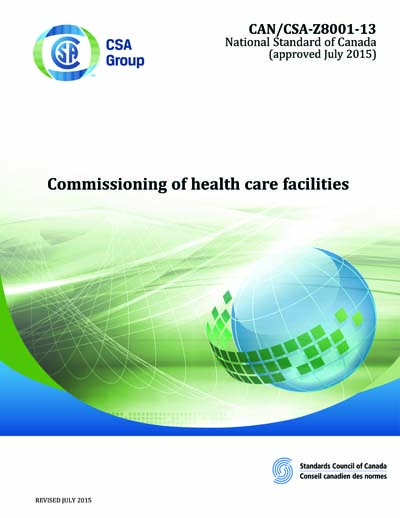Historical
CSA Z8001-2013 (R2015)
Z8001-13 (R2015) - Commissioning of health care facilities
Preface
This is the first edition of CSA Z8001, Commissioning of health care facilities. It supersedes the previous CSA Group Standards for this subject, published in 1993 and 2005 under same title, but with the designations Z318.0 and Z318. This Standard provides requirements for the commissioning of health care facilities and all related building systems. The superseded Z318 Standards were stand-alone documents. With the publication in 2011 of the general standard, Z320 Building commissioning , the Technical Committee on Health Care Facility Engineering and Physical Plant agreed to use Z320 as the basis of a new Standard, as a companion document to the new Z8000 Canadian health care facilities. This Standard includes most of Z320, as well as additional requirements and guidance specific to health care facilities. It applies to new construction and to renovations of existing buildings or facilities. Note: The Preface and committee lists for CSA Z320 have been provided in Annex N for reference.Scope
1.1 General 1.1.1 This Standard provides requirements for the commissioning of health care facilities and all related building systems. It applies to new facilities, and renovations and additions to existing facilities. This Standard is based on CSA Z320, Building commissioning, with additions as appropriate to address the special requirements for health care facility commissioning. 1.1.2 This Standard is intended to assist the commissioning team in the preparation and implementation of a commissioning plan. This plan specifies commissioning requirements for newly installed or renovated building systems and includes, but is not limited to, descriptions of the following: a) the commissioning process; b) the resources required to complete commissioning; c) the responsibilities of the commissioning team; and d) the sequence and integration of commissioning activities. 1.1.3 This Standard applies to building services that support medical equipment and systems, but does not apply to the operational commissioning of the equipment or systems, whether installed by the owner or by others. Note: Although the commissioning activities under this Standard do not include the commissioning of medical equipment and systems (e.g., sterilizers and MRI machines) the facility commissioning process is likely to include steps to ensure that contracts with external companies for equipment commissioning are being followed. 1.1.4 The Standard does not include clinical commissioning. Note: Clinical commissioning refers to the activities undertaken to determine the readiness of staff, procedures, and other non-infrastructure elements of the clinical program prior to commencement of patient care. This is generally done in-house as part of the program team requirements. 1.2 Specific systems 1.2.1 General The systems covered in this Standard include, but are not limited to a) architectural (building envelope, fenestration, door hardware and interior space assemblies that are environmental separators); b) vertical and horizontal transportation systems; c) mechanical systems, including- i) plumbing systems (domestic cold and domestic hot water, storm and sanitary drain systems, medical gases, fuel oil systems); ii) HVAC and refrigeration systems; and iii) fire protection and fire suppression;
- a) emergency duress stations; b) multiple utility service connections; and c) exterior storage of medical gases.
Content Provider
CSA America, Inc. [csa]






